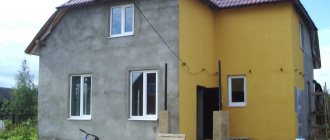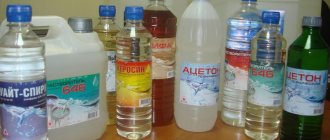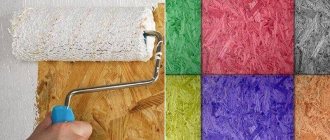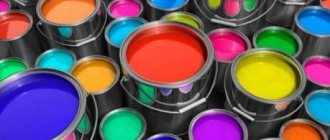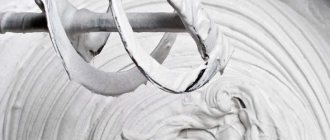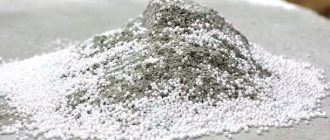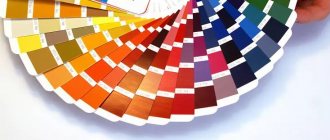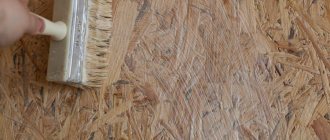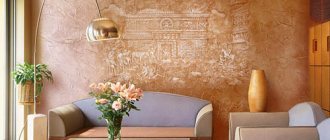Home / Tips for painting / Selection rules / What paint to choose for wood and how to paint
Wood is a very popular natural building material. At the same time, it is quite vulnerable to adverse external factors, so the need to paint it arises quite often. Proper processing of wooden surfaces significantly increases their durability and wear resistance.
What problems does painting a wooden surface solve?
Modern paint and varnish materials can prevent:
- rotting and oxidation of wood;
- its drying out and fading;
- damage by mold and insects.
Painted wooden structures gain improved performance and increased attractiveness. However, in order to obtain the required result, finishing paint alone will not be enough: you will first have to use special impregnations and primers. They fill wood pores and prepare the base for subsequent decorative work. Only such an integrated approach provides the finished surface with excellent technical characteristics. What paint to choose for wood?
What to look for when choosing paint
When choosing the appropriate composition, you should pay attention to several factors.
- Type of wood . Different breeds have their own characteristics, which affect the quality of coloring.
- Terms of Use . Surfaces indoors and outdoors are exposed to varying degrees of impact. When purchasing paints and varnishes, it is recommended to take into account: humidity, the presence of sunlight, exposure to smoke, temperature changes, mechanical stress and some other nuances.
- Preliminary surface treatment . For the most effective protection of wood and long service life, the surface must be primed before painting. This will enhance the protective properties and ensure the leveling of the absorbent base.
- Previously applied compounds . The primer must be compatible with the paint. Otherwise, it is better to completely remove the previously applied layer.
Manufacturers
When choosing the really best paint for wood, pay attention to its packaging, components, and expiration date.
Good manufacturers produce their products in sealed containers, convenient for long-term storage. They also label the product correctly, indicating on the packaging all the information necessary for the consumer.
Among the already established manufacturers of wood painting products:
- Tikkurila is a Finnish brand that specializes in the production of all kinds of finishing materials. Although its products have a fairly high price compared to others, it is fully compensated by quality. Painting wooden lining, ceilings, floors, furniture, windows and doors with materials from this manufacturer will give them an excellent appearance and protection from environmental influences;
- Alpina - products are manufactured in Germany, have an attractive price and good quality. The manufacturer produces materials for both exterior finishing of wooden buildings and interior work. The advantage is a wide color palette;
- Neomid is a domestic manufacturer that can easily compete with foreign companies. Neomid produces interior paint for wood with increased fire-resistant properties;
- Belinka is a medium-priced, high-quality product from Slovenia. It has a wide range of finishing materials for wood, including protection against fungus, moisture, sun, and chemicals. This product is easy to work with, as it has an optimal texture and does not spread on the surface.
Now you know that when choosing what paint to paint a wooden house inside or outside, you need to pay attention to the main characteristics and positive properties of the available range and purchase what is best suited for your case and budget. However, remember that good and correctly selected finishing materials will help keep the treated surface intact and neat for a long time and will allow you to make repairs much less frequently
For lovers of natural compositions, we recommend that you get acquainted with such a material as paint with wax for walls. This may be what you need. You may also be interested in learning how to paint the steps of a wooden staircase.
What types of paints and varnishes for wood are there?
For woodworking, glazes and antiseptics, varnishes, water-based impregnations and stains, as well as covering paints and enamels are used. Let's look at each type in more detail.
Glazing coatings (impregnations, glazes, varnishes) . The texture of the wood is clearly visible through the applied layer. Such materials help preserve the natural appearance of the wooden surface and give a decorative effect, emphasizing the advantages of the surface.
Covering compositions (oil, alkyd, acrylic paints) . These materials are made on different bases, both organic and water-based. Alkyd and oil paints are more traditional and affordable, but less durable. Acrylic paints are famous for their durability and wear resistance. Their advantages also include quick drying and lack of odor.
Opaque enamels (alkyd, acrylic, polyurethane). These compositions are also produced with the participation of polymers. After drying, they form a hard layer resembling a “crust”, which provides them with resistance to external factors. The most affordable is alkyd enamel. It reliably protects the wooden surface from moisture, however, such compounds are the most toxic. Polyurethane paints are characterized by good elasticity, due to which they are resistant to mechanical stress and last longer than others.
Basic properties
Applying a coating (paint and varnish) to wooden surfaces is necessary to protect against destructive factors, protect against microorganisms and, of course, to update the color and give a beautiful appearance. Painted wooden surfaces become more stable and do not deteriorate from moisture.
Wood paint for interior work is available in two variations:
- water-based – based on liquid polymers;
- water-dispersion - based on solid polymers.
These two versions are similar; as they dry, moisture evaporates and the plasticizers acquire hydrophobic properties.
Wood paint intended for interior use is a special type that is characterized by safety, instant drying and uniform, easy application to the prepared surface.
With the modern composition, the surface will be ready within 2 hours after application. As a result, you get a dense layer that does not allow water and steam to pass through. At the same time, it is safe and can also be used in a children's room.
Wood coatings are divided into matte and glossy, and also into subtypes - semi-matte and semi-gloss, which are used in their own way in the interior. Manufacturers produce mixtures with special qualities, for which several components are added to the paint - fire retardants and antiseptics. Fire retardants make it possible to reduce flammability, and antiseptics protect wood surfaces from the occurrence of fungi and mold.
Popular paintwork materials
Let us dwell in detail on the most common paints that can be used for wood processing.
Acrylic paints and enamels . Acrylic paints and enamels are water-based and practically odorless, dry quickly, are environmentally friendly and durable. Such materials are usually excellent for exterior and interior use. Modern covering materials have a wide range of colors, while the brightness of the coatings is maintained for a long time. Any method (brush, roller or spray gun) can be used to apply the compositions. Facade covering paints perfectly withstand high and low temperatures, as well as direct ultraviolet rays, since their composition, as a rule, includes special additives (wax, oil, UV filters and light-resistant pigments). The paint protects the wood surface from destruction when exposed to moisture, without clogging its pores. It is prohibited to store water-based materials at sub-zero temperatures.
Alkyd paints and enamels . They are attractive due to their affordable price and variety of shades, and you can tint them yourself. Such materials are allowed to be used for both internal and external work, since they tolerate precipitation and other adverse external influences well. However, for indoor use, paints based on organic solvents are less preferable due to their pungent odor. Structures treated with this type of material can be used even at temperatures above -30 °C. This surface dries within 8-24 hours, but the paint almost does not penetrate the wood fibers. It is customary to use alkyd compounds for wooden street structures, entrance doors or window frames.
Oil paints . They perfectly protect wood from water, but in terms of performance they are in many ways inferior to other analogues. In particular, they take a relatively long time to dry, about 2 days, have a strong smell and often form smudges. You should also take into account their poor compatibility with other paints and varnishes and insufficient wear resistance. Inexpensive oil paints fade very quickly in sunlight. However, these materials also have advantages: low consumption and excellent elasticity.
Water-based polymer-based paints . The main advantages of these compositions are the absence of odor and environmental safety. They are not suitable for outdoor work because they do not tolerate high humidity and other unfavorable external factors. Because of this feature, they are not recommended for use in the kitchen, bathroom or bathhouse. However, some varieties, due to the presence of special polymers in their composition, acquire the necessary water resistance. But their cost is quite high compared to other paints of this type.
Polyurethane paints and varnishes . Often used to stain wood floors and furniture. These compounds are non-toxic, and the layer they form is resistant to mechanical stress and elastic. Polyester paints. These materials are made using polyester resins. They are expensive, so they are used mainly for restoration work on wood. They are also used for decorative processing of various products.
Nitrovarnishes . Used for decorative processing of wooden products and elements indoors. These compositions are flammable and susceptible to ultraviolet rays, so they are not used for outdoor use. Their main area of application is finishing wooden furniture and indoor elements.
Polyvinyl acetate composition
Polyvinyl acetate paint composition
This composition, in addition to the coloring element, contains water. Its distinctive feature is the ability to create a serious protective layer, but at the same time it can be washed off with cleaning products. Polyvinyl acetate (PVA) composition is a paint that dries very quickly even in a damp environment, for example, in a bathroom, sauna or kitchen.
Requirements for paints for exterior use
When choosing paint for exterior use, you should pay attention to how resistant it is to a number of factors:
- humidity;
- sun rays;
- high and low temperatures;
- detergents and chemicals;
- rotting;
- fungal development;
- reproduction of pests.
Such compositions are allowed to be used in the temperature range from -40 to +50 degrees. It is desirable that they lay easily and evenly on the surface and have protective and decorative properties. Paints for exterior use must be wear-resistant, vapor-permeable and durable.
To paint outdoor objects, you can safely use water-based façade materials and acrylic enamels. If you have to save your budget, then alkyd enamels are a good option, but you need to take into account that such a coating will last a much shorter period of time.
For re-dyeing
The easiest option for choosing paint for repainting is the same as what is already on the walls (furniture, floor, ceiling).
It can be applied directly to old layers, which, of course, will speed up the process. The fact is that the coloring liquid, first applied to untreated wood, immediately penetrates deep into the material. This is one of the main reasons why it is better to use the same dyes that were used the first time when refinishing wood.
But this method is not always relevant. If you want to achieve a truly magnificent result and radically transform the situation, then first it is better to remove the old coating completely. And after this, you can apply paint to the surface, selected in accordance with all existing conditions.
Requirements for paints for interior work
Interior paints must meet the following criteria:
- health safety;
- high drying speed;
- no pungent odor;
Wear resistance for such materials is not so important. Exceptions include floor, bathroom or kitchen paints. Acrylic and polyurethane water-dispersed compositions are ideal for treating indoor surfaces. However, they are relatively expensive, which limits their growth in popularity.
Thus, the choice of paint and varnish materials is influenced by many factors: from the financial capabilities of the buyer to the operating conditions of the painted products. If you encounter any difficulties, you can always turn to salespeople at retail outlets for help.
